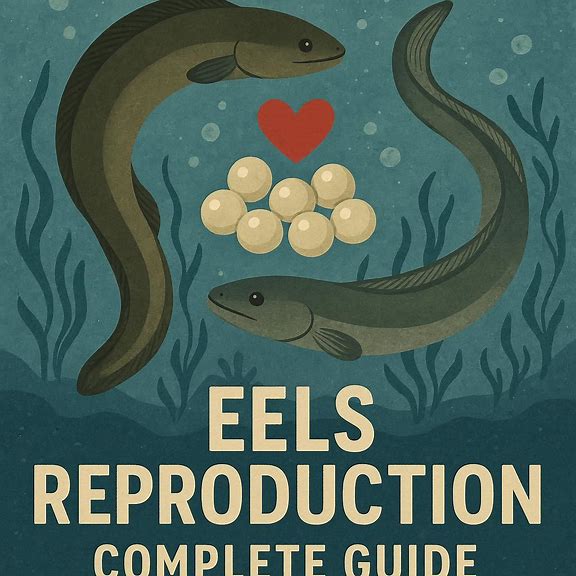
Eels are fascinating creatures that inhabit both freshwater and saltwater environments. Their reproductive process is quite unique and involves complex migrations, secretive behaviors, and remarkable physiological changes. In this article, we will provide a comprehensive guide on how eels reproduce, shedding light on their reproductive strategies, mating behaviors, and the incredible journeys they undertake to ensure the survival of their species.
1. Life Cycle of Eels
The life cycle of eels is divided into several distinct stages, each characterized by specific behaviors and habitat preferences. The primary stages include the leptocephalus larval stage, the glass eel stage, the elver stage, and the yellow eel/adult stage.
2. Migratory Behavior
Eels are known for their extensive migrations, which are vital for their reproductive success. Most eel species undertake long-distance migrations from their freshwater or estuarine habitats to the open ocean, where they spawn and eventually die. These migrations can span thousands of kilometers and often occur during specific times of the year.
3. Reproductive Strategies
Eels exhibit two primary reproductive strategies known as catadromy and amphidromy.
– Catadromy
Catadromous eels, such as the European eel (Anguilla anguilla), undertake migrations from freshwater or brackish habitats to the ocean to spawn. After reaching the ocean, adult eels release their eggs into the water, where they are fertilized externally by the males. The eggs develop into small, transparent larvae known as leptocephali, which drift with ocean currents for months or even years.
– Amphidromy
Amphidromous eels, such as the freshwater eels of the genus Anguilla, have a slightly different reproductive strategy. They migrate from freshwater to the ocean during the early stages of their life cycle and then return to freshwater to complete their growth and maturation. Once they reach sexual maturity, these eels undergo another migration to the ocean to spawn.
4. Spawning Behavior
Spawning behavior in eels is still not fully understood, as it occurs in deep oceanic waters that are challenging to observe. However, it is believed that eels engage in mass spawning events, where males and females release their gametes simultaneously. The fertilized eggs then develop into the leptocephalus larvae, which are transparent and have a leaf-like shape.
5. Larval Development
Leptocephalus larvae are carried by ocean currents, traveling vast distances over long periods. During this larval stage, they undergo gradual transformation and grow in size. This stage is critical for their survival, as they rely on the nutrients in the water and the oceanic ecosystem to sustain their development.
6. Arrival as Glass Eels
After months or years of drifting, the leptocephalus larvae transform into a different stage called glass eels. Glass eels are transparent and have the characteristic eel shape. They migrate back to coastal areas and enter freshwater or brackish habitats, navigating their way through rivers, estuaries, and even climbing over obstacles to reach their desired destination.
7. Transformation into Elvers
Once the glass eels reach their desired freshwater or brackish habitat, they undergo another transformation and become elvers. Elvers have a more pigmented appearance and are capable of adapting to a wider range of environmental conditions. They continue their migration upstream, often traveling during the night to avoid predators and find suitable habitats.
8. Maturation as Yellow Eels and Adult Stage
As elvers continue their upstream migration, they gradually develop into yellow eels, which are sexually immature adults. Yellow eels spend a significant portion of their lives in freshwater or brackish habitats, feeding and growing. This stage can last several years, and during this time, eels undergo physiological changes to prepare for their final migration and reproductive phase.
9. Silvering and Final Migration
When yellow eels reach sexual maturity, they undergo a process called silvering. Their bodies darken, and they develop a silvery appearance. This transformation is believed to be associated with the hormonal changes that prepare eels for their final migration back to the ocean.
10. Spawning and Semelparity
Upon reaching the ocean, eels engage in a phenomenon called semelparity, where they reproduce once and then die. The exact details of eel spawning in the open ocean are still largely unknown, but it is thought that males release sperm and females release eggs simultaneously. The fertilized eggs develop into leptocephalus larvae, restarting the eel life cycle.
Conclusion
Eel reproduction is a complex and captivating process that involves remarkable migrations, metamorphosis, and reproductive strategies. From the tiny transparent leptocephalus larvae drifting in the open ocean to the determined glass eels and elvers navigating their way through rivers, eels undertake incredible journeys to ensure the survival of their species. Understanding the intricacies of eel reproduction enhances our appreciation for the remarkable diversity and resilience of these enigmatic creatures.
FAQs (Frequently Asked Questions)
- How long does it take for eels to reach sexual maturity?
- The time it takes for eels to reach sexual maturity varies depending on the species and environmental conditions. In general, it can take anywhere from 5 to 20 years for eels to become sexually mature.
- Do all eels die after spawning?
- Yes, most eel species die after they spawn. This phenomenon is known as semelparity, where eels reproduce once and then succumb to exhaustion and natural causes.
- Can eels reproduce in captivity?
- Reproducing eels in captivity is challenging and has not been widely successful. The complex migratory behavior and specific environmental conditions required for eel reproduction make it difficult to replicate in artificial settings.
- How far do eels migrate during their reproductive journeys?
- Eels can migrate vast distances during their reproductive journeys. Some species, such as the European eel, undertake migrations spanning thousands of kilometers from freshwater or estuarine habitats to the open ocean.
- Are all eels catadromous or amphidromous?
- No, not all eels exhibit catadromous or amphidromous behavior. Some eel species, particularly those that inhabit deep-sea environments, have different reproductive strategies that are still not fully understood.






